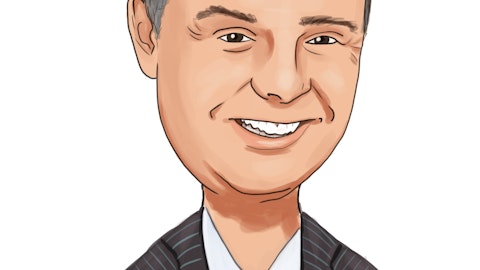Byline Bancorp, Inc. (NYSE:BY) Q3 2023 Earnings Call Transcript October 27, 2023
Operator: Good morning, and welcome to the Byline Bancorp Third Quarter 2023 Earnings Call. My name is Adam, and I’ll be your commerce operator today. All lines have been placed on mute to prevent any background noise. After the speakers’ remarks, there will be a question-and-answer period. [Operator Instructions] Please note the conference call is being recorded. At this time, I would like to introduce Brooks Rennie, Head of Investor Relations for Byline Bancorp to begin the conference call.
Brooks Rennie: Thank you, Adam. Good morning, everyone. And thank you for joining us today for the Byline Bancorp third quarter 2023 earnings call. In accordance with regulation FD, this call is being recorded and is available via webcast on our Investor Relations website, along with our earnings release and the corresponding presentation slides. During the course of the call today, management may make certain statements that constitute projections or other forward-looking statements regarding future events or the future financial performance of the company. We caution that such statements are subject to certain risks, uncertainties and other factors that could cause actual results to differ materially from those discussed. The company’s risk factors are disclosed and discussed in its SEC filings.
In addition, our remarks may referenced non-GAAP measures, which are intended to supplement, but not substitute for the most directly comparable GAAP measures. Reconciliation for these numbers can be found within the appendix of the earnings release. For additional information about risks and uncertainties, please see the forward-looking statement and non-GAAP financial measures disclosures in the earnings release. I would now like to turn the conference call over to Alberto Paracchini, President of Byline Bancorp.
Alberto Paracchini: Thank you, Brooks. Good morning, everyone, and thank you for joining the call this morning to go over our third quarter results. With me on the call are Roberto Herencia, our Chairman and CEO; Tom Bell, our CFO; and Mark Fucinato, our Chief Credit Officer. Before we get into the results for the quarter, I’d like to pass the call on to Roberto for to comment on a few items.
Roberto Herencia: Thank you, Alberto, and good morning to all. We had another strong quarter and are delighted to have welcomed our inland colleagues and shareholders after a successful core system conversion and integration in the third quarter. Speaking about welcoming, it is important to call out the addition of two very accomplished individuals to our Board. You have seen their bios, so I won’t go into those details. Pamela Stewart joined us as part of — at the close of the inland merger in early July. We did not know Pam other than through our selection and evaluation process at the board level. But we can tell you that in just a few months that we’ve been working with her, we’re just delighted with her contributions, and we know we’ve made a great selection there.
Carlos Ruiz Sacristán joined the Board in early October. We have known Carlos for many years. And more importantly, he knows us very well. Carlos is the identical twin brother of the late Jaime Ruiz Sacristán, who was one of our founding shareholders and served on our Board. The addition of these two individuals keeps in line with our commitment to building diverse, high-performing teams at all levels that reflect our core values of diversity and inclusion and we believe these make us stronger. In an environment where Mr. Market has elected to punish the banking sector. Our performance and execution have been excellent. We saw nothing mixed this quarter other than Mr. Market being significantly disconnected from our strong fundamentals, as Alberto and the team will cover.
We have been posting top quartile numbers in several important metrics. In this quarter, some of those metrics move even higher or into the top quartile. But these are just numbers. And what really matters to us, people, strategy and long-term shareholder value, we feel uniquely positioned, especially because of the uncertainty in the economy. We have created a place where the best lenders want to work and grow in a market handing us disruption opportunities. In addition, we have strategic pathways for inorganic value creation such as the inland merger that you just saw. On top of that, we have a very special group of long-only long-term shareholders, which provide us the runway where this value creation started to unfold for years to come, and I want to highlight for years to come.
I think this is easy and Christa did enough for analysts and Mr. Market to grasp. It connects us to the future. You can use quarters as signposts, but understand that this is much more than that. Alberto, I’d like to turn it back to you.

A security officer in front of a bank vault, representing the companies secure transportation services.
Alberto Paracchini: Great. Thank you, Roberto. In terms and moving on to the agenda, I’ll start with some comments and highlights for the quarter. Tom will follow and cover the financial results in detail, and then I’ll come back and wrap-up at the end before we open the call up for questions. As a reminder, the deck we’re using for today’s call is on our website, so please refer to the disclaimer at the front. Starting on slide 3 of the deck. The third quarter was not only a strong quarter financially for the company, but also a very productive one. During the quarter, we closed the Inland merger on July 1st and successfully completed the systems conversion in mid-August and wrapped up the integration project by quarter end.
The merger added roughly $1 billion in deposits, $800 million in loans and 10 branches located primarily in attractive west and northwest suburbs of Chicago. I’d like to welcome all former Inland customers, employees and stockholders to Byline. Lastly, I’d like to thank all of our colleagues who played a critical role in making the conversion and integration projects as success. We reported net income of $28 million or $0.65 per share on revenue of $105 million. These results include the impact of merger-related charges taken in connection with the Inland transaction. Excluding the impact of these, net income was $33 million or $0.77 per diluted share. These figures represent new benchmarks for the company since our IPO, with increases of 5% and 40% on a quarter-on-quarter and year-on-year basis, respectively.
Profitability and return metrics were also strong with an ROA of 130 basis points and an ROTCE of 16.15%. Adjusting for merger-related charges, ROA was 153 basis points and ROTCE just under 19%. Our pretax pre-provision income hit a record $46.9 million, which translates to a pretax pre-paration ROA of 216 basis points or 246 basis points one excluding merger-related charges. Total revenue was $105 million, up $14 million for the quarter and 30% year-on-year. Growth in the quarter was driven by a $16 million or 21% increase in net interest income, stemming from higher loan balances. Noninterest income declined largely due to a negative fair value mark on our servicing asset, despite increased gain on sale revenue. Expenses inclusive of all merger-related charges were $58 million for the quarter, up 17%.
Excluding charges, operating expenses remain well managed at $51 million, marking a 6.8% increase from the prior quarter. Operating expenses relative to assets came in at 235 basis points, excluding charges, representing a 25 basis point improvement from the prior quarter and a 21 basis point improvement year-on-year. The margin remained strong at 446 basis points, which includes approximately 50 basis points of loan accretion income coming from the transaction. Excluding acquisition accounting, the margin came in as expected at just over 400 basis points. As an aside, I’d like to point you to additional disclosures we added in the appendix related to loan accretion income on Slide 18 and updated slides on Pages 15 and 16 on our office exposure inclusive of inland.
Lastly, our efficiency ratio stood at 53.7% or 47.3% adjusted, which represents a 4 and 7 percentage point improvement over the prior quarter and year, respectively. Moving on to the balance sheet. Loans increased by approximately $1 billion and stood at $6.6 billion as of quarter end. The increase was primarily due to the inland transaction, notwithstanding, excluding the impact, we still saw growth in the portfolio of approximately $216 million or 4% on a linked-quarter basis. This marked the 10th consecutive quarter of loan growth for the company. Business development activity remained healthy, driven by our commercial and leasing businesses. Our government-guaranteed lending business also had a good quarter, with commitments closed totaling $113 million.
Deposits as of quarter end stood at $7 billion, up $1 billion largely due to the transaction. Adjusting for that, deposits increased by $74.4 million or 5.8% on a linked quarter basis. Asset quality inclusive now of the inland portfolio remained stable for the quarter. Credit costs came in at $9 million, inclusive of net charge-offs of $5.4 million and the reserve build of $2.6 million. The allowance for credit losses ended the quarter at 1.6% of total loans. Liquidity and capital remained ample and strong with a CET1 ratio of 10.1% and total capital of 13.2%. TCE ended the quarter at 8.18%, which is within our targeted operating range of 8% to 9%. Moving forward, our capital priorities remain unchanged. And with that, I’d like to pass the call over to Tom, who will provide you with more detail on our results.
Tom Bell: Thank you, Alberto, and good morning, everyone. Starting with our loan and lease portfolio on Slide 4. Total loans and leases were $6.6 billion at September 30th, an increase of $1 billion from the prior quarter. Inland contributed approximately $800 million in total loans. Notwithstanding, we saw increases across all of our major lending areas with the strongest growth coming from commercial and leasing teams. Net of loans sold, we originated $311 million during the quarter and payoffs were lower than we expected at $185 million compared to $256 million in the second quarter. Looking ahead, we expect loan and lease growth to be in the low to mid-single digits for the remainder of the year. Turning to Slide 5. Our government-guaranteed lending business finished the quarter with $113 million in closed loan commitments which was lower than the second quarter.
At September 30th, the on-balance sheet SBA 7(a) exposure was relatively unchanged, and we saw an uptick in the USDA business. Our allowance for credit losses as a percentage of the unguaranteed loan balances was 8.1% as of quarter end, lower as a result of loan upgrades and payoffs. Turning to Slide 6. Total deposits increased to $7 billion at September 30th. Deposits grew $74.4 million or 5.8% annualized from the end of the prior quarter. DDA as a percentage of total deposits was 28% compared to 30% from the prior quarter. The change in mix was primarily driven by a lower DDA percentage on the assumed deposit portfolio. Commercial deposits represent 48% of total deposits and accounts for 77% of non-interest-bearing deposits. Our deposit costs for the quarter came in at 213 basis points, an increase of 43 basis points from the prior quarter, which was primarily driven by higher rates on money market accounts and time deposits.
On a cycle-to-date basis, deposit betas, both for total deposits and interest-bearing deposits stood at 39% and 55%, respectively. Turning to Slide 7. Net interest income was $92.5 million for Q3, up 21% from the prior quarter, primarily due to the merger, organic loan and lease growth, and higher yields offset by increased interest expense. Our net interest margin was 4.46%, up 14 basis points from the prior quarter, stemming primarily from the merger. Accretion income on acquired loans contributed 50 basis points to the margin in the third quarter, up from three basis points in last quarter. Earning asset yields increased a healthy 50 basis points driven by higher loan yields. Going forward, given the higher-than-expected accretion in Q3, we estimate net interest income of $85 million to $87 million for Q4.
Turning to Slide 8. Non-interest income stood at $12.4 million in the third quarter, down $1.9 million linked quarter, primarily driven by a $3.6 million negative fair value mark on our loan servicing asset due to higher discount rates and increased prepayments, which was partially offset by an increase of $769,000 in net gain on sale of loans due to higher volumes. Sales of government-guaranteed loans increased $16 million in the third quarter compared to Q2. The net average premium was 8% for Q3, lower than the prior quarter, primarily due to changes in the mix of loans sold and tight market conditions. Assuming we avoid a government shutdown in November, we are forecasting gain on sale income in the $5.5 million range for Q4. Turning to slide 9, our non-interest expense came in at $58 million for the third quarter, up $8.6 million from the prior quarter, primarily due to the impact of the Inland acquisition.
On an adjusted basis, our net interest expense stood at $51.2 million, $2 million below our Q3 guidance of $53 million to $55 million. We continue to remain disciplined on our expense management, and we are on track to meet projected cost savings. With one-time merger cost behind us, our non-interest expense guidance is unchanged at $53 million to $55 million per quarter. Expenses are well managed, and we believe we have the right balance of investing versus spending to achieve our strategic goals. Turning to slide 10. The allowance for credit losses at the end of Q3 was $105.7 million, up 14% from the end of the prior quarter. The increase includes an adjustment of $10.6 million for Purchase Credit Deteriorated loans, PCD and a $2.7 million provision for acquired non-PCD wells.
In total, for the quarter, we recorded a $9 million provision for credit losses, compared to $6 million in Q2. Net charge-offs were $5.4 million in the third quarter, compared to $4.3 million in the previous quarter. NPLs to total loans and leases increased 79 basis points in Q3, from 69 basis points in Q2. The increase in NPLs was attributed entirely to loans assumed as part of the merger. NPAs to total assets increased to 60 basis points in Q3 from 54 basis points in Q2. And total delinquencies were $36.9 million on September 30 a $27 million increase in the linked quarter. The increase was primarily due to the merger, which contributed approximately half of the delinquency increase. Turning to slide 11. We ended the quarter with approximately $429 million in cash and $1.2 billion of securities, which represents roughly 19% of total assets.
Our available borrowing capacity stood at $1.7 billion and our uninsured deposit ratio stood at 26.1%, which remains well below all Pure Bank averages. Total security yields increased a healthy 39 basis points to 2.48% from Q2. Turning to slide 12. Our CET1 came in at 10.1% and our TCE ratio stood at 8.2% and remains within our targeted TCE range. Going forward, we are focused on executing our strategy, and we expect our capital levels to grow given our earnings outlook. With that, Alberto, back to you.
Alberto Paracchini: Thank you, Tom. So to wrap-up, on slide 13, you have a summary of our strategy, which has remained consistent and continues to work very well for us. We were pleased with another quarter of strong results and notwithstanding the significant sources of uncertainty present in the environment. We remain optimistic about our ability to continue to differentiate ourselves in the marketplace and deliver results for both our customers and stockholders. With that, operator, let’s open the call up for questions.
Operator: [Operator Instructions] Our first question today comes from Damon DelMonte from KBW. Damon, please go ahead. Your line is open.
See also 10 Best Ways to Prevent Type 2 Diabetes and 30 Most Expensive Cities to Visit in the US.
Q&A Session
Follow Byline Bancorp Inc. (NYSE:BY)
Follow Byline Bancorp Inc. (NYSE:BY)
Damon DelMonte: Hey, good morning, everyone. I hope you’re all doing well today.
Roberto Herencia: Good morning, Daman.
Damon DelMonte: Good morning. Just wanted to start off with a question on the margin. So the reported margin, I think it was like 4.47, and you guys had noted there was around 50 basis points of benefit from the merger accounting there. And you did provide a table in a slide deck with expected accretable yield going forward. So do we basically just take out the $10.3 million this quarter to get to a core number of like 3.97. And then if we kind of layer on the expected accretable yield, we can kind of back into the core margin for next quarter to get to the guided NII, is that fair, Tom? So, I guess what I’m trying to get at is it sounds like the core margin is trending lower from third quarter to fourth quarter.
Tom Bell: I think that’s generally accurate. I think you have to remember that there’s a number of repricing things going on. And I think that you would see the margin stable to maybe slightly up just given we have balance sheet hedges. And we have the SBC loans repriced to another 25 basis points higher in Q4. So I would say flat to slightly up.
Roberto Herencia: I think the construct to add to what Tom was saying, Damon, I think the construct is correct. I think you’re thinking about it the same way. Just one word of caution with accretion that’s our best guess, obviously, as it’s going to fluctuate. In some cases, we may see that accretion to par be faster. I think you saw some of that this quarter. But that’s our best estimate at this point in time. Just know that it can vary plus or minus some percentage on a quarter in, quarter out basis. The second point to just add to what Tom said is, I think what you’re seeing, absent another increase in rates or call it a significant change in short-term market rates as I think the margin, call it, the core margin, so to speak, is reached a trough, so to speak.
So just plus or minus. I mean, we — it’s impossible to predict these things within a basis point or two, but just plus or minus, just know that it could bounce around a little bit. But generally speaking, what we’re seeing is probably relatively flat core number with the accretion number on top. Hope that helps.
Damon DelMonte: Got it. It does. Yes. Thank you for that color and clarification. And then with regards to the expenses, Tom, I think you said that the guide for next quarter is in the $53 million to $55 million range. Is that correct?
Tom Bell: Yes.
Damon DelMonte: So if we were to kind of back out the merger charges in the quarter and I think…
Tom Bell: Sorry, I didn’t mean to interrupt you. Go ahead, Damon. That goes beyond the fourth quarter.
Damon DelMonte: It goes beyond the fourth quarter, okay. But if we kind of back out the nonrecurring, nonoperating stuff here in this quarter, we’re in the $51 million range. Is that fair?
Tom Bell: Yes.
Damon DelMonte: So, I guess, what’s the transition from this quarter’s level up to that 53% to 55%? Are there – just inflationary expenses that are causing us to go higher, or are there may be some onetime savings this quarter that don’t recur in the coming quarters?
Tom Bell: I mean, there’s a little of the — we don’t expect many acquisition costs, merger related costs in Q4, we think we’re done. And then there’s obviously some employees that work through the conversion, so to speak, that are no longer here. So there’ll be some saves there, but we are dealing with inflationary pressures. And we think given the projects and the things we want to continue to invest in the business, we’re trying to find some other opportunities, but we’re trying to manage to the lower end of the range.
Damon DelMonte: Got it. Okay. That’s helpful.



